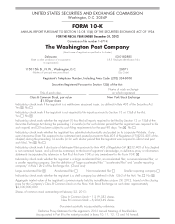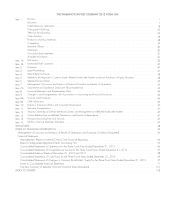Washington Post 2012 Annual Report Download - page 18
Download and view the complete annual report
Please find page 18 of the 2012 Washington Post annual report below. You can navigate through the pages in the report by either clicking on the pages listed below, or by using the keyword search tool below to find specific information within the annual report.interest rates, changes in the U.S. Federal poverty income level relevant for calculating the discretionary income test,
changes in the percentage of former students who are current in repayment of their student loans and other factors.
Incentive Compensation. Under the incentive compensation rule, an institution participating in Title IV programs may not
provide any commission, bonus or other incentive payment based directly or indirectly on success in securing enrollments
or financial aid to any person or entity engaged in any student recruiting or admission activities or in making decisions
regarding the awarding of Title IV funds. Effective July 1, 2011, the DOE enacted changes to the incentive compensation
rule that reduced the scope of permissible payments under the rule and expanded the scope of payments and employees
subject to the rule. Prior to the effective date of the rules, the DOE issued a “Dear Colleague Letter,” providing guidance
on these rules. Kaplan has taken steps to fully comply with these rules and the guidance. Among the actions taken,
Kaplan has revised its compensation plans for admissions personnel and eliminated enrollment results as a component in
the determination of compensation. Kaplan believes that this change in its approach to recruiting has adversely impacted,
and will continue to adversely impact, its enrollment rates, operating costs, business and results of operation. Kaplan
cannot predict how the DOE will interpret and enforce all aspects of the revised incentive compensation rule in the future.
The 90/10 Rule. Under regulations referred to as the 90/10 rule, a KHE school would lose its eligibility to participate
in Title IV programs for a period of at least two fiscal years if the institution derives more than 90% of its receipts from Title
IV programs, as calculated on a cash basis in accordance with the Higher Education Act and applicable DOE
regulations, in each of two consecutive fiscal years, commencing with the institution’s first fiscal year that ends after
August 14, 2008. An institution with Title IV receipts exceeding 90% for a single fiscal year ending after August 14,
2008, will be placed on provisional certification and may be subject to other enforcement measures. The 90/10 rule
calculations are performed for each OPEID unit. The largest OPEID reporting unit in KHE in terms of revenue is Kaplan
University, which accounted for approximately 65% of the Title IV funds received by the division in 2012. In 2012,
Kaplan University derived less than 80% of its receipts from the Title IV programs, and other OPEID units derived between
71% and 88% of their receipts from Title IV programs. For 2012, a portion of the non-Title IV receipts resulted from the
Kaplan Value Loan program, which has been discontinued. In 2011, Kaplan University derived less than 82% of its
receipts from Title IV programs, and other OPEID units derived between 71% and 88% of their receipts from Title IV
programs.
A majority of KHE students are enrolled in certificate and associate’s degree programs. Revenue from certificate and
associate’s degree programs is composed of a higher percentage of Title IV funds than is the case for revenue from its
bachelor’s and other degree programs. KHE is taking various measures to reduce the percentage of its receipts
attributable to Title IV funds, including modifying student payment options; emphasizing direct-pay and employer-paid
education programs; encouraging students to carefully evaluate the amount of their Title IV borrowing; eliminating some
programs; cash-matching; and developing and offering additional non-Title IV-eligible certificate preparation, professional
development and continuing education programs. Some of the other programs may currently be offered by other Kaplan
businesses. Absent the adoption of the changes mentioned above, and if current trends continue, management estimates
that in 2013, 20 of the KHE Campuses’ OPEID units, representing approximately 21% of KHE’s 2012 revenues, could
have a 90/10 ratio over 90%. As noted above, Kaplan is taking steps to address compliance with the 90/10 rule;
however, there can be no guarantee that these measures will be adequate to prevent the 90/10 rule calculations at
some or all of the schools from exceeding 90% in the future.
Change of Control. If one or more of Kaplan’s schools experiences a change of control under the standards of
applicable state agencies, accrediting agencies or the DOE, the applicable schools governed by such agencies must
seek the approval of the relevant agencies. A school that undergoes a change of control, which may include a change of
control of a school’s parent corporation or other owners, must be reviewed and recertified by the DOE and obtain
approvals from certain state agencies and accrediting bodies, in some cases prior to the change of control. The
standards pertaining to a change of control are not uniform and are subject to interpretation by the respective agencies.
Certifications obtained from the DOE following a change in control are granted on a provisional basis that permits the
school to continue participating in Title IV programs, but provides fewer procedural protections if the DOE asserts a
material violation of Title IV requirements.
Standards of Financial Responsibility. An institution participating in Title IV programs must maintain a certain level of
financial responsibility as determined under the Higher Education Act and under DOE regulations. The DOE measures an
institution’s financial responsibility by compiling a composite score ranging from 0 to 3.0 pursuant to a formula that
incorporates various financial data from annual financial statements submitted to the DOE. If an institution fails to achieve
a composite score of 1.5 or fails to comply with other financial responsibility standards, then the DOE may place
conditions on the institution’s participation in the Title IV programs and may require the institution to submit to the DOE a
letter of credit in an amount of at least 10% to 50% of the institution’s annual Title IV participation for its most recent fiscal
6THE WASHINGTON POST COMPANY
























